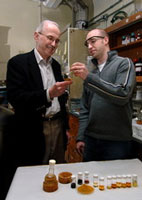 Alcohol will be powering the 2007 Rahal-Letterman Racing team in more ways than one.
Alcohol will be powering the 2007 Rahal-Letterman Racing team in more ways than one.
The number 17 Team Ethanol car will be driven once again by Jeff Simmons and sponsored, of course, by the ethanol industry. The second car in the RLR stable will be Number 8, piloted by veteran IndyCar Series driver Scott Sharp and sponsored by Patrón Spirits Company premium brand tequila.
During a press conference Thursday, Rahal-Letterman co-owner Bobby Rahal praised Jeff Simmons’ efforts this year, coming on board after the tragic death of driver Paul Dana before the first race of the season. “It was some difficult shoes to fill and he came in and with each race gained more and more confidence,” Rahal said. “And with Jeff we are fortunate to have the relationship with the ethanol industry.”
The IndyCar Series is making the switch to 100 percent ethanol in 2007 and Rahal said they have been very pleased with the results of the fuel. “Any myths that were associated with lack of performance (regarding ethanol) have been shattered.”
Driver Jeff Simmons is looking forward to his first full year with the IndyCar Series and Rahal-Letterman and said his goals for 2007 are simple, “To win races and be a good spokesman for ethanol.”
Tom Slunecka, executive director of the Ethanol Promotion and Information Council, said the ethanol industry’s partnership with Rahal-Letterman and the Indy Racing League has taken ethanol to new heights. “The ‘e’ on the side of that car is starting to represent more than just a brand for a commodity product. It really is a movement that has been strengthening, letting consumers know the performance in that Indy Car can be purchased locally at their gas station.”
Read more from EPIC.
 Ethanol for the 2007 IndyCar Series will be supplied by Renova Energy of Wyoming.
Ethanol for the 2007 IndyCar Series will be supplied by Renova Energy of Wyoming.

 Alcohol will be powering the 2007
Alcohol will be powering the 2007 


 A 40-year-old discovery is showing promise as a chemical pre-treatment that breaks down plant fiber. That could release the simple sugars in corn stalks or switchgrass so they can be fermented into ethanol. And that could add value to Iowa’s crops or the fibrous co-products of ethanol production. John Verkade, left, a University Professor of chemistry at Iowa State, and Reed Oshel, a graduate student in biorenewable resources and technology, are studying the compound which they are not identifying as they explore patent options.
A 40-year-old discovery is showing promise as a chemical pre-treatment that breaks down plant fiber. That could release the simple sugars in corn stalks or switchgrass so they can be fermented into ethanol. And that could add value to Iowa’s crops or the fibrous co-products of ethanol production. John Verkade, left, a University Professor of chemistry at Iowa State, and Reed Oshel, a graduate student in biorenewable resources and technology, are studying the compound which they are not identifying as they explore patent options. 


 Ten truckers will be driving a million miles over the next two years to study and promote the benefits of soy biodiesel.
Ten truckers will be driving a million miles over the next two years to study and promote the benefits of soy biodiesel.